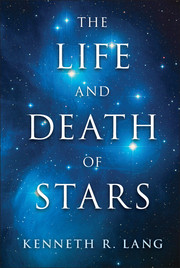Book contents
- Frontmatter
- Contents
- List of Focus Elements
- List of Tables
- Preface
- 1 Light of the Sun
- 2 Gravity and Motion
- 3 Atomic and Subatomic Particles
- 4 Transmutation of the Elements
- 5 What Makes the Sun Shine?
- 6 The Extended Solar Atmosphere
- 7 Comparisons of the Sun with Other Stars
- 8 The Lives of Stars
- 9 The Material Between the Stars
- 10 New Stars Arise from the Darkness
- 11 Stellar End States
- 12 A Larger, Expanding Universe
- 13 Birth, Life, and Death of the Universe
- Quotation References
- Author Index
- Subject Index
- Plate section
13 - Birth, Life, and Death of the Universe
Published online by Cambridge University Press: 05 February 2013
- Frontmatter
- Contents
- List of Focus Elements
- List of Tables
- Preface
- 1 Light of the Sun
- 2 Gravity and Motion
- 3 Atomic and Subatomic Particles
- 4 Transmutation of the Elements
- 5 What Makes the Sun Shine?
- 6 The Extended Solar Atmosphere
- 7 Comparisons of the Sun with Other Stars
- 8 The Lives of Stars
- 9 The Material Between the Stars
- 10 New Stars Arise from the Darkness
- 11 Stellar End States
- 12 A Larger, Expanding Universe
- 13 Birth, Life, and Death of the Universe
- Quotation References
- Author Index
- Subject Index
- Plate section
Summary
Hotter Than Anything Else
Regardless of the direction in which we look out into space, almost all of the distant galaxies are flying apart, dispersing and moving away at speeds that increase with their distance, as if they had been ejected by a cosmic bomb. Astronomers call it the “big bang.” We are participating in its explosion, watching it blow up before our eyes.
We can envision this early state by putting the observed expansion of the galaxies in reverse, pushing the galaxies back closer together until a time – about 13.7 billion years ago – when the universe was incredibly small and all of its mass was compressed to a very high density.
Because gases become hotter when they are compressed and cool when they expand, the observed universe must have been incredibly hot in its earliest, most compact state. As we look back in time, the universe becomes increasingly hotter, eventually becoming so exceptionally hot that radiation was the most powerful force, dominating the expansion of the universe.
In the earliest moments of the big bang, there were no stars or galaxies, only intense radiation and subatomic particles from which the material universe subsequently grew. This condition seems to have been described in Genesis, the first book of the Bible, in which God said “Let there be light ” or, as in the popular spiritual, “I got a home in glory land that outshines the Sun.”
In the early stages, the radiation controlled the expansion of the universe, essentially because it was incredibly hot. Just 1 second after the big bang, the radiation had a temperature of about 10 billion, or 1010, K. As the universe continued to expand, the radiation steadily cooled and began its long descent into darkness, when matter eventually took over the expansion. However, the big bang was so intense and so hot that we are still immersed within the radiation.
- Type
- Chapter
- Information
- The Life and Death of Stars , pp. 287 - 312Publisher: Cambridge University PressPrint publication year: 2013

